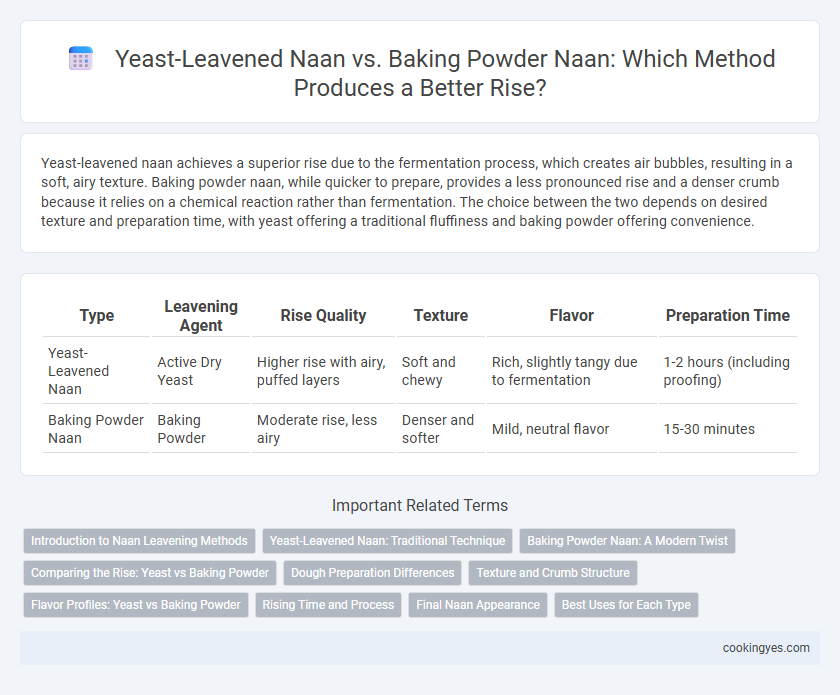Yeast-leavened naan achieves a superior rise due to the fermentation process, which creates air bubbles, resulting in a soft, airy texture. Baking powder naan, while quicker to prepare, provides a less pronounced rise and a denser crumb because it relies on a chemical reaction rather than fermentation. The choice between the two depends on desired texture and preparation time, with yeast offering a traditional fluffiness and baking powder offering convenience.
Table of Comparison
| Type | Leavening Agent | Rise Quality | Texture | Flavor | Preparation Time |
|---|---|---|---|---|---|
| Yeast-Leavened Naan | Active Dry Yeast | Higher rise with airy, puffed layers | Soft and chewy | Rich, slightly tangy due to fermentation | 1-2 hours (including proofing) |
| Baking Powder Naan | Baking Powder | Moderate rise, less airy | Denser and softer | Mild, neutral flavor | 15-30 minutes |
Introduction to Naan Leavening Methods
Yeast-leavened naan achieves a characteristic airy texture and complex flavor through fermentation, allowing gluten to develop and gas bubbles to form for optimal rise. Baking powder naan, on the other hand, relies on chemical leavening, producing a quicker rise with a slightly denser crumb and less pronounced taste. Understanding these leavening methods is crucial for mastering naan's texture and authenticity.
Yeast-Leavened Naan: Traditional Technique
Yeast-leavened naan achieves a superior rise compared to baking powder naan due to the fermentation process, which creates air bubbles that expand during baking, resulting in a soft and airy texture. This traditional technique enhances flavor complexity through the slow development of natural yeast, producing a slightly tangy taste not found in baking powder variants. Yeast-leavened naan requires longer preparation time but yields a distinctive, fluffy bread integral to authentic Indian cuisine.
Baking Powder Naan: A Modern Twist
Baking powder naan offers a reliable rise by releasing carbon dioxide quickly during baking, resulting in a soft and fluffy texture without the extended fermentation time required by yeast. This modern twist simplifies preparation and ensures consistent results, making it ideal for quick meals and novice cooks. While it lacks the complex flavor development of yeast-leavened naan, baking powder naan delivers a tender, mildly leavened bread with a pleasantly airy crumb.
Comparing the Rise: Yeast vs Baking Powder
Yeast-leavened naan achieves a superior rise due to the fermentation process, which produces carbon dioxide and creates a light, airy texture with distinct bubbles. Baking powder naan rises quickly through a chemical reaction, but its texture tends to be denser and less flavorful compared to yeast-based naan. The slow fermentation in yeast-leavened naan also enhances gluten development, resulting in a more elastic and chewy bread.
Dough Preparation Differences
Yeast-leavened naan dough requires a longer fermentation period, allowing natural yeast to produce carbon dioxide, which creates a soft, airy texture and distinct flavor. In contrast, baking powder naan dough depends on a chemical reaction for immediate leavening, resulting in a quicker preparation but a denser, less complex crumb structure. The choice between yeast and baking powder significantly influences dough hydration, resting times, and the overall bread rise quality.
Texture and Crumb Structure
Yeast-leavened naan develops a light, airy texture with a chewy crumb structure due to the fermentation process creating gas bubbles that expand during baking. Baking powder naan results in a denser, more tender crumb with a finer texture, lacking the characteristic elasticity of yeast-based dough. The choice between yeast and baking powder significantly impacts the naan's mouthfeel and ability to hold toppings or dips.
Flavor Profiles: Yeast vs Baking Powder
Yeast-leavened naan develops a complex, slightly tangy flavor due to fermentation, enhancing the bread's aroma and depth with subtle fruity and sour notes. In contrast, baking powder naan offers a milder, more neutral taste, as the chemical leavening agent produces carbon dioxide without affecting the dough's flavor. The yeast's slow fermentation process contributes to a richer, more traditional naan experience, while baking powder yields a quicker rise but simpler flavor profile.
Rising Time and Process
Yeast-leavened naan requires a rising time of 1 to 2 hours, allowing the yeast to ferment and produce carbon dioxide, resulting in a soft, airy texture with a pronounced flavor. Baking powder naan rises instantly during cooking, offering convenience with no fermentation time but yields a denser, less complex crumb. The yeast process involves proofing and gradual dough expansion, while baking powder relies on chemical reaction activated by heat for immediate lift.
Final Naan Appearance
Yeast-leavened naan achieves a superior rise, resulting in a soft, airy texture with characteristic bubbles and a slightly chewy crust, enhancing both visual appeal and mouthfeel. Baking powder naan, while quicker to make, often produces a denser, flatter bread with fewer bubbles and less pronounced puffiness, leading to a more uniform but less textured surface. The final appearance of yeast-leavened naan is typically more rustic and artisanal, making it visually distinct from the smoother, more compact look of baking powder naan.
Best Uses for Each Type
Yeast-leavened naan offers a deep, complex flavor and a soft, airy texture ideal for traditional Indian dishes like butter chicken or biryani, where a chewy, pillowy consistency enhances the meal. Baking powder naan produces a quicker, denser bread with a tender crumb suited for everyday meals or as a wrap for sandwiches, providing a reliable rise without the need for extended fermentation. Choosing between yeast and baking powder depends on preparation time and desired texture, with yeast preferred for authentic taste and baking powder favored for convenience.
Yeast-leavened naan vs Baking powder naan for rise Infographic

 cookingyes.com
cookingyes.com